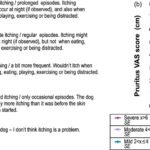In this study, there is a great discussion to help vets and animal owners review the evidence for the use of PEA for pain and inflammation in their pets.
There are some fairly unpleasant things done to pets to test the effects of PEA. In one section (Figure 6), they compare the effect of hemp oil extract (HOE) on heat hyperalgesia – which showed that both used together have a greater-than-additive effect. This also showed that PEA had multiple forms of action for relief of pain and hypersensitivity, as well as pain-induced cognitive impairments. (Means they felt better.)

This is a long study, and highly technical – vets can dig in. The rest of us will need to use websearch regularly to find out what they are talking about. Here is the interesting part of the study summary:
“The recent understanding of the role of non-neuronal cells in pain processing is uncovering potential new targets for managing chronic pain. Furthermore, it is becoming increasingly clear that enhancing endocannabinoid signalling may prevent patients from developing persistent or chronic pain states mainly through non-neuronal cell modulation. One such strategy is the dietetic use of the endocannabinoid-like PEA. As reviewed here, there is now strong evidence supporting the dietary supplementation with PEA (either as alternative or add-on to conventional treatment) in the management of chronic pain. Such a critical mass of data is being generated that PEA is currently listed among the novel nonopioid interventions to chronic pain [270].”
PEA is becoming extremely popular with humans for the relief of chronic inflammation and pain, as well as use by the anti-aging crowd. Use in the vet and pet world is also increasing rapidly, as PEA is a non-addictive, safe (found in breast milk for example, as well as in every mammalian cell), and can be used alongside practically all known pharmaceuticals as interactions are very rare (unknown).
PEA is odourless and tasteless, and be simply sprinkled onto pets food avoiding the challenges of tablets and capsule dosing.





